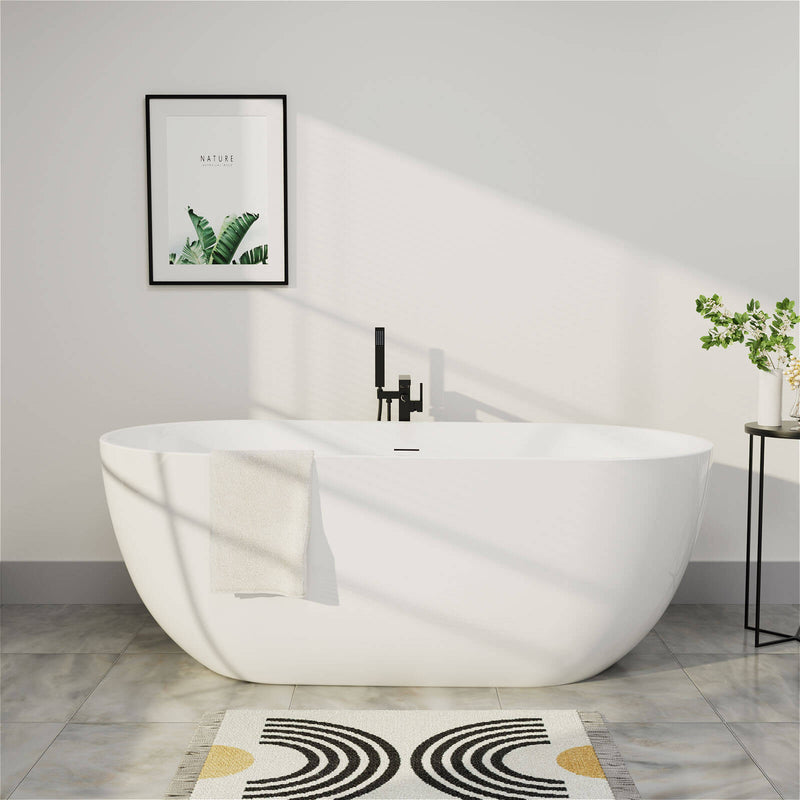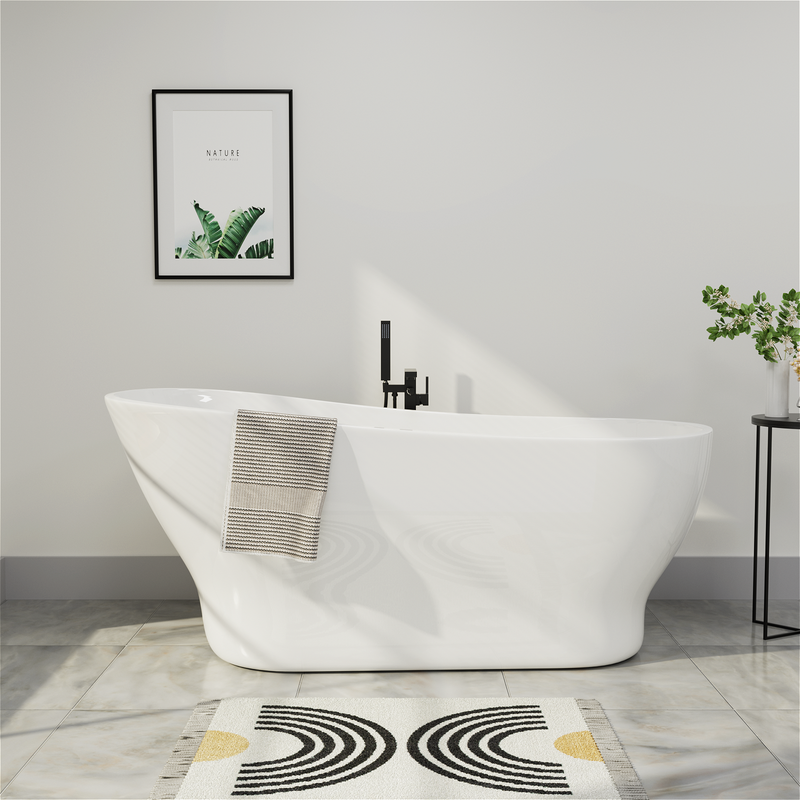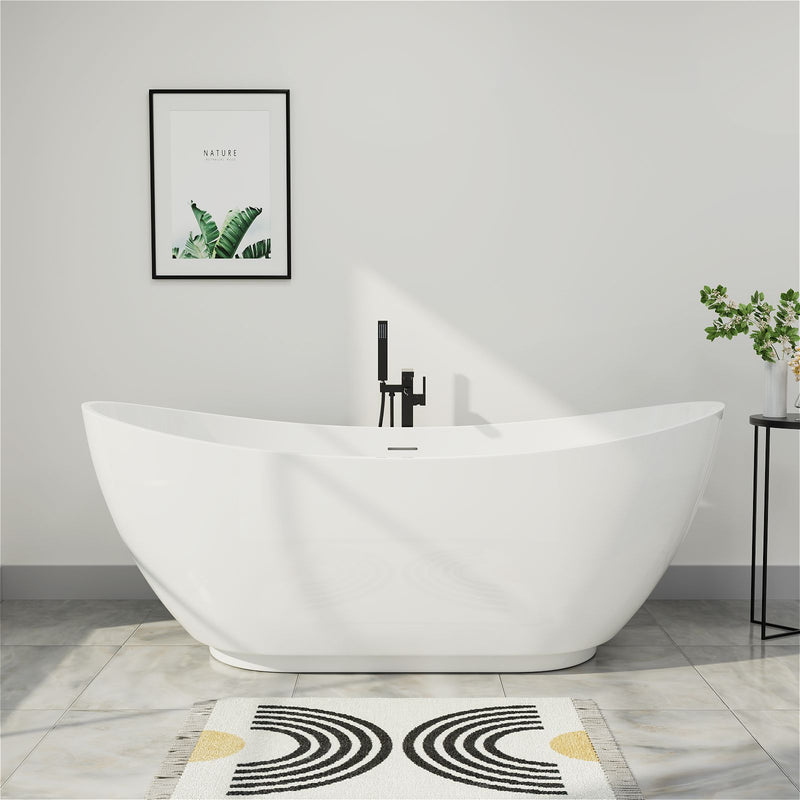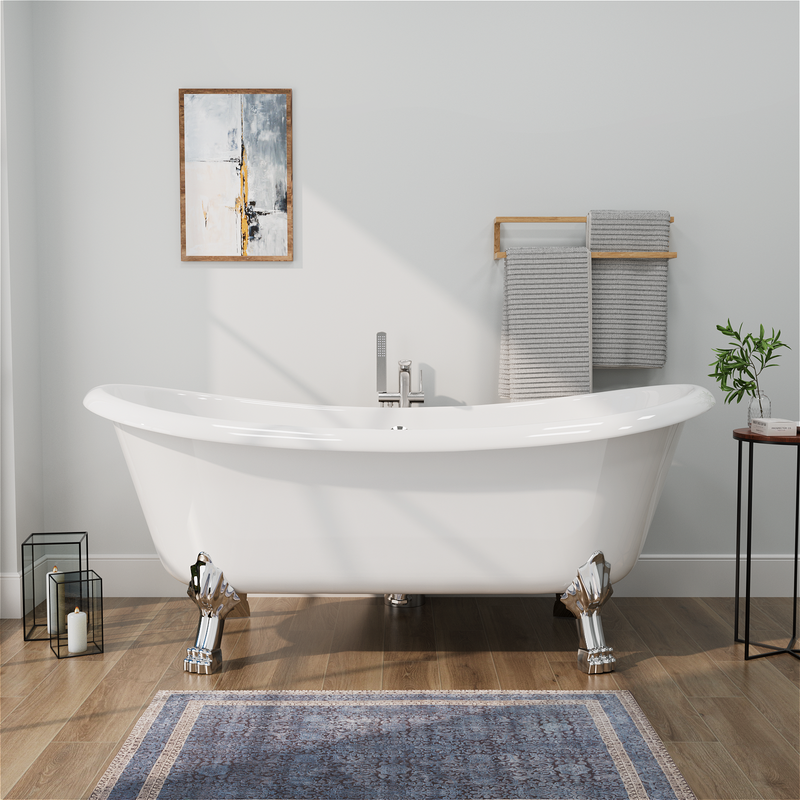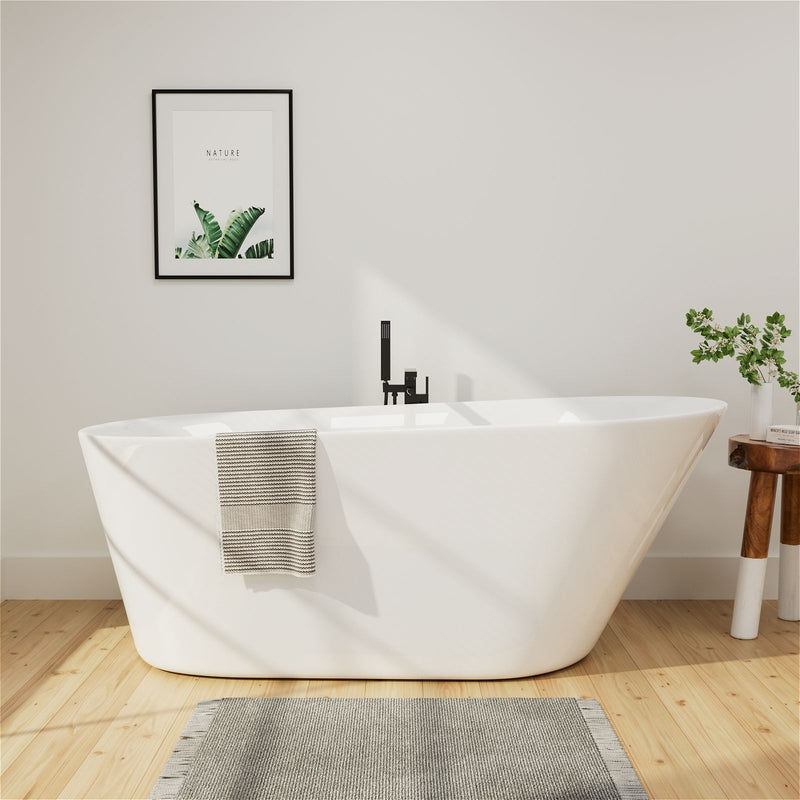What is a Freestanding Tub?
A freestanding tub is exposed on all four sides and usually sits directly on the floor. A freestanding tub is a visual focal point in a bathroom. It is striking because it stands alone, uninterrupted by all surrounding walls and fixtures, except for the plumbing. Unlike most home tubs, which are hidden in a niche between three walls, a freestanding tub is not integrated into the architectural design of the bathroom. This means you have complete freedom in choosing the location, size, shape, and material of your tub.
You can place a freestanding tub anywhere in the room. The only restriction is that it must be located in a location that allows access to the faucet and the drainage plumbing for the tub basin. The layout and shape of a freestanding tub can be as vintage or modern as you want, and will directly affect the design scheme of the rest of the room.

Depending on the location of the bathroom and the strength of the floor, you can choose an antique or replica cast iron clawfoot tub, or one made from a lighter material like acrylic or fiberglass. Some newer freestanding tub designs even offer jets or other luxury features to incorporate this classic style into a modern home. The final choice is up to you, your budget, and the plumbing facilities available in your bathroom.
Advantages of a Freestanding Bathtub
Flexibility
One of the biggest advantages of a freestanding bathtub is its flexibility. While built-in bathtubs usually need to be mounted against a wall, a freestanding bathtub can be installed anywhere. If you have enough space in your bathroom, you can even place the bathtub in the middle of the room.
Unique Style
One of the best things about a freestanding bathtub is that it makes a statement. When friends and family walk into your bathroom, they will definitely take a second look at your bathtub. Many homes today have built-in bathtubs, so a freestanding bathtub will really make your bathroom stand out, especially when it is installed in the middle of the room.
Wide Range of Colors and Designs
Freestanding bathtubs come in a variety of different colors and designs, so you can be sure to find one that matches your bathroom decor. For example, if you want your bathtub to be off the floor, you can buy a bathtub with a pedestal. The claw-foot double slipper style can complement antique or vintage-style decor.
Material
A wide range of choices Freestanding bathtubs are available in a variety of materials. For example, cast iron bathtubs are durable and can last for decades. Another option is acrylic and solid surface bathtubs, which will give you a very solid feel; it is bold and adds a unique touch to the room.
Vintage Touch
If you love nostalgia, you'll love a freestanding bathtub. This style can add a touch of vintage to your bathroom, making it feel like you've stepped back in time.
The Illusion of Extra Space
A freestanding tub takes up more space than a drop-in tub, but your bathroom won't appear smaller. In fact, installing one can create the illusion of more space. The open area beneath the tub can make the bathroom appear larger than it actually is.
Disadvantages of a Freestanding Bathtub

Inconvenient to Place Items
One of the biggest concerns about choosing a freestanding bathtub is that they don't allow you to easily store shampoo and other essential sundries. Drop-in bathtubs usually have protruding shelves on two or three sides, making it easy to access your toiletries. If you opt for a clawfoot tub, you'll have to think of ways to keep bathroom essentials within easy reach. Sure, it's an easy fix, but not everyone likes to have a bathroom cluttered with clutter, especially if space is tight.
Complex Plumbing Required
Whether it's freestanding or built-in, any bathtub requires some basic plumbing: a water source (faucets for built-in bathtubs can be mounted on the wall or patio), a drainage system, and an overflow to prevent overflows if you forget to turn off the water. But freestanding bathtubs may require additional pipes to pass through the floor. If you want to buy a bathtub with legs, you first need to consult a professional plumber to see if your current plumbing and drainage system allows such a project or if you need to rewire before you can enjoy a refreshing swim in a stylish freestanding bathtub.
Cleaning will be Troublesome
Another important thing to keep in mind before buying a freestanding bathtub is that the bottom of the bathtub needs to be cleaned. Of course, the surrounding area of the bathtub also needs to be cleaned. Even if the bathtub is legless and the bathtub is flush with the wall, there will be a gap between the bathtub and the wall, which may be difficult to reach when cleaning. However, if the freestanding bathtub is placed in the center of the room or far enough away from the wall, it will be easier to clean.
Sloping Floors Bring Additional Troubles
The charm of a freestanding bathtub is that it is stunning, eye-catching, and effortlessly becomes the focal point of the room. However, in a house with sloping floors, such a bathtub may bring additional troubles. Some bathrooms have sloped floors to allow for easier drainage. While wall-mounted tubs can effectively adapt to uneven floors, freestanding tubs may require additional, professional installation work to fit on sloped floors without compromising drainage.
Inconvenient Showering
Technically, it is possible to equip a freestanding tub with a shower, but this would require a curtain or a cubicle, which completely defeats the purpose of a freestanding tub.
If your bathroom is not heated enough, you may want to consider enclosing the tub with a shower curtain to keep it warm. A ceiling-mounted shower curtain rod and shower head can do this neatly, just make sure the curtain remains open so your tub can still showcase its timeless appeal. Additionally, a built-in tub can give you more flexibility for an easy, clutter-free shower experience while still enjoying the pleasures of a fully functional bathtub. Keep this in mind if you prefer showers to baths.
How to Choose a Freestanding Tub?
Choosing the Right Size and Shape
To find the ideal freestanding tub, you need to carefully consider size and style to ensure it enhances the functionality and design of your bathroom. Mokleba offers freestanding bathtubs in a variety of sizes and shapes to suit different layouts and personal preferences, ensuring there is a perfect bathtub for every space.

Space Planning
Before deciding on a design, it is important to assess the size and layout of your bathroom. Freestanding bathtubs require ample space around them, not only for aesthetic reasons, but also for ease of movement and practicality. Make sure the bathtub is positioned so that it can fit in the space and connect easily with other bathroom units.
Considering the external dimensions of the bathtub is key to determining its compatibility with your space. Check if the bathtub can fit through doorways and hallways (usually the bathtub will need to be placed on its side, so compare the width of the doorway with the height of the bathtub). The height of the bathtub is also a practical factor to consider in daily use to ensure easy entry and exit.
Explore Bathtub Shapes
Freestanding bathtubs come in a variety of shapes, including elegant ovals, classic rectangles, and other unique designs. When choosing between an oval or rectangular bathtub, it is important to consider the size constraints of your bathroom. Generally, rectangular bathtubs take up more space than oval bathtubs, making them less suitable for small bathrooms. On the other hand, oval bathtubs are compact in size and are often a better choice for limited spaces.
Focus on Ergonomics
The shape of your chosen bathtub should be ergonomic and provide a comfortable and relaxing soaking experience. Design features such as curved edges and adequate depth can significantly increase comfort and ensure complete immersion. Choose a bathtub design with a gentle slope that supports your back while providing a comfortable resting experience, resulting in a more therapeutic and enjoyable bathing experience.
To assess the comfort of a bathtub, consider its internal dimensions, especially the size of the tub base. Compare your sitting length from the tub wall to your toes to the tub dimensions to ensure that there is enough room to stretch out and sit. Your lounging style will determine the importance of length, width, and depth.
Choose the Right Materials
The material choice for a freestanding bathtub will affect its look, feel, lifespan, and maintenance. Consider factors such as durability, ease of maintenance, and visual appeal when making your decision.
Acrylic
Acrylic bathtubs are popular for their lightness, ease of installation, affordability, and heat-retaining properties. Acrylic bathtubs are versatile and come in a variety of shapes and sizes, and are known for being durable, hard-wearing, and easy to clean due to their smooth, non-porous surface.
Fiberglass
Fiberglass is another affordable bathtub material. This tub is constructed with multiple layers of surface coating, polyester resin, and fiberglass reinforcement. Fiberglass bathtubs are cheaper than acrylic, but also less durable.
Enameled Steel
Enameled steel bathtubs are a common and affordable option. They are made of steel sheets coated with an enamel coating. They are slightly heavier than acrylic or fiberglass bathtubs, but much lighter than the old-fashioned enameled cast iron bathtubs.
Enameled Cast Iron
Enameled cast iron is a classic bathtub material that is very durable and heavy. The bathtub is made of cast iron and coated with an enamel glaze. Cast iron bathtubs are a high-end choice, but they are also a lasting investment. Enameled cast iron bathtubs are highly regarded for their durability. The material can also be refinished if damaged, further extending its lifespan.
The only significant disadvantage (and a very serious one) is the weight. Cast iron bathtubs are quite difficult to install (and remove) because they are so heavy and may require structural reinforcement of the floor.
Cast Polymer
Cast polymer bathtubs are made from materials such as artificial natural stone and solid surface materials. These materials are molded from minerals, polymer materials, and resins to form a solid material similar to solid surface countertops such as Corian. Tubs are often finished with a gel coat finish. Seamless and durable, these tubs are stain and scratch resistant, and come in a variety of designs and finishes for design flexibility. They are also easy to maintain and retain heat.
Style and Design Considerations
You should look for a freestanding tub that matches your personal style and fits in with your bathroom design. Whether you prefer sleek, modern design or classic charm, there is a freestanding tub that will suit your aesthetic. From bright white to bold matte finishes, the color and finish of your tub are crucial to creating the mood of your bathroom. Whether you are updating a vintage bathroom or creating a minimalist haven, Mokleba has something to suit your design needs.
Bathtub Faucet Options
A stylish faucet is the perfect finishing touch for a freestanding tub, complementing the tub design while also enhancing its functionality. From freestanding, countertop, to wall-mounted, a variety of faucets are available. The latest trend in freestanding bathtub faucet design is a sleek, minimalist aesthetic with plenty of customization options to create a unique look that matches your style.
When choosing a faucet for your freestanding bathtub, consider factors such as type, size, stability, material, flow rate, and compatibility. It is recommended to choose a faucet made of durable materials, such as solid brass or stainless steel, and ensure that it feels sturdy and stable when held. In addition, make sure the faucet meets the design and installation requirements of the bathtub to add seamless and practical functionality to your bathroom.
Installation and Plumbing Requirements
Although freestanding bathtubs may seem simpler to install compared to built-in or alcove bathtubs, there are still specific issues to consider in terms of placement and plumbing.
At Mokleba, we emphasize that professional installation of freestanding bathtubs is essential to ensure optimal performance and maintain the warranty period. Professional installation ensures that the bathtub is installed correctly and meets all necessary plumbing requirements.
Budget and Cost Considerations
The investment in a freestanding bathtub should be measured not only in terms of its initial cost, but also in terms of its long-term value. It is wise to compare the cost with durability and maintenance costs to determine the true value of the bathtub. Sometimes, a larger upfront investment can save you money in the long run because the tub will last longer. High-quality tubs can provide decades of comfort and luxury, making them a worthwhile investment for both your home's comfort and resale value.
How to Install a Freestanding Bathtub?
Tools and Materials Needed to Install a Freestanding Bathtub
Before installing a freestanding bathtub in your bathroom, make sure you have all the necessary installation materials ready. The following list of materials will help you install the bathtub smoothly.

Cleaning Materials: Materials such as rags and plastic sheets used to protect and clean the floor before and after installation.
Level: A device used to determine the levelness of the bathroom floor.
Lumbar Support for 4x4: The lumbar support for the entire bathtub system during installation.
Recessed Drain: This is a must-have tool if your bathroom does not have a drainage channel.
Caulking: Prevents leaks and ensures that all joints fit tightly.
Plumber's Putty: It seals all seams to prevent leaks, similar to caulk.
Silicone: Helps secure the bathtub to the bathroom floor after installation.
Plumbing Accessories: You must ensure all the necessary plumbing, such as sealing washers. Your bathtub supplier will provide the materials needed for installation, but you must ensure that all accessories are provided correctly and that no accessories are missing before installation.
Protective Blanket: It helps protect the sides of the bathtub when it is tilted during installation.
Things to Ensure Before Installation
Step 1: Slope
Make sure that the bathroom has a proper slope. If the floor lacks a slope, the water flow to the drain will not work properly, which will cause the drain to be blocked and cause financial losses. You can use a level to measure the vertical and horizontal position of the bathroom. Once you know this information, you can proceed to the next step.
Step 2: Placement
Freestanding bathtubs have a unique design that can add elegance to your bathroom. Freestanding bathtubs come in a variety of sizes and shapes to suit different types of bathrooms.
Based on the information you have gathered from the level, you must choose a bathtub that suits your style and looks good. You can place a freestanding bathtub almost anywhere, such as in a corner, against the wall, or even in the middle of the bathroom. However, you must ensure that the plumbing is intact where you are installing the bathtub. If not, then you must contact a plumber.
Step 3: Clean the Bathroom Floor
After deciding where to install the bathtub, you must clean the entire bathroom floor to prevent dust and debris from accumulating under the bathtub. A simple cleaning will do, and you must clean it again after the installation is complete.
Steps to Install a Freestanding Bathtub
Once you have met the prerequisites, you can install the bathtub in the bathroom.
Step 1: Place the protective blanket in the area adjacent to where you want to install the tub. It will protect the sides of the tub while you install it.
Step 2: Now, place the 4x4 lumber in the area where you want to install the tub. Place the tub on the lumber and align the drain with the tub drain.
Step 3: Freestanding tubs come with a drain kit. If not, be sure to purchase it along with the tub. You can take out the drain kit and align it with the bathroom drain. Make sure to tighten the drain nut in place to avoid leaks. You must also clean the tub's drain to remove any dirt and debris left over from the factory.
Step 4: Clean the bathroom drain hole. This will help avoid water blockages while installing. Drain cleaner or bleach will do. Once the drain is completely dry, take a small amount of clear silicone and apply it to the bottom of the pipe flange.
Step 5: Install the drain tailpiece to the bottom of the tub. Place the rubber or plastic bushing with the plumbing material on top of the tailpiece and tighten the drain nut onto the pipe until both the tub drain and the drain tailpiece are tight. Now you have to apply lubricant to the seal to ensure that the pipe joints will not leak.
Step 6: Apply caulk to the bottom edge of the tub. Remove the lumbar support and carefully lower the tub to the floor. Wipe away any excess caulk and debris with a damp cloth, then cover the tub drain and floor with plumber's putty.
Now you have to clean the area thoroughly, put the tools away, and wait 24 hours to give the lubricant and caulk time to adhere properly and prevent leaks.
After 24 hours, fill the tub with water and check for leaks. If everything is in good condition, you can treat yourself to a relaxing bath.
Frequently Asked Questions About Freestanding Bathtubs
Q1: What is the main difference between a freestanding tub and a built-in tub?
A: Freestanding tubs are not attached to walls or surrounded by frameworks, offering complete design flexibility and often serving as a bathroom centerpiece. Built-in tubs (or drop-in tubs) are installed within a deck or alcove, supported by walls on three sides.
Q2: Can I install a freestanding tub by myself?
A: While lightweight acrylic or fiberglass models may be manageable for experienced DIYers, we recommend professional installation. Proper leveling, plumbing alignment (especially for floor-mounted faucets), and ensuring structural support are critical for long-term performance.
Q3: Do freestanding tubs require special plumbing?
A: Yes. Freestanding tubs often need floor-mounted or wall-mounted faucets with exposed piping. Ensure your drain and water supply lines are positioned to match the tub’s design. Retrofitting may require additional plumbing adjustments.
Q4: Are freestanding tubs suitable for small bathrooms?
A: Absolutely. Compact models (e.g., 55-60 inches long) or oval-shaped tubs can fit snugly into corners. Pair with a wall-mounted faucet to save space and create an open feel.
Q5: How do I clean and maintain an acrylic freestanding tub?
A: Use a soft cloth and mild, non-abrasive cleansers. Avoid harsh chemicals or scrubbing pads that could scratch the surface. Rinse thoroughly and dry after each use to prevent water spots.
Q6: Do freestanding tubs come with an overflow drain?
A: Most modern freestanding tubs include an overflow drain as a standard safety feature. However, check product specifications before purchasing, as some minimalist designs may omit it.
Q7: What flooring is best under a freestanding tub?
A: Ensure your floor is level and structurally reinforced. Waterproof materials like tile, vinyl, or sealed concrete are ideal. Use a waterproof mat or pad beneath the tub if installing over hardwood.
Q8: Can I add a shower to a freestanding tub?
A: Yes, but you’ll need a freestanding tub shower kit (including a ceiling-mounted or wall-mounted rail, showerhead, and waterproof curtain). Note that splashing may occur, so proper ventilation and floor drainage are essential.
Q9: Are freestanding tubs comfortable for long soaks?
A: Yes! Many models feature ergonomic slopes, armrests, and deepened basins for full-body immersion. Acrylic also retains heat better than cast iron or steel.

